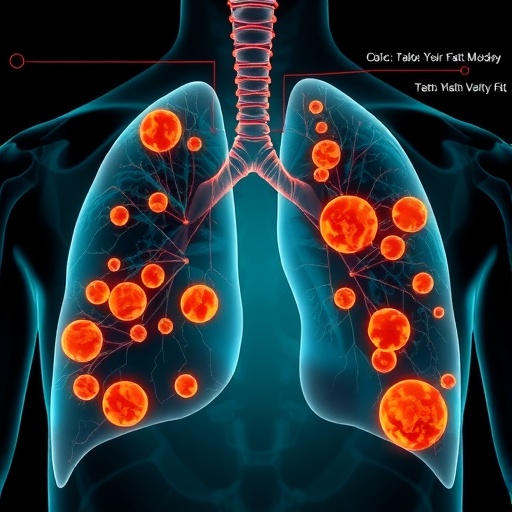
In an era where artificial intelligence is rapidly transforming various fields, the realm of medical imaging has seen profound advancements through the application of deep learning techniques. A recent study has spotlighted an innovative approach in the classification of pulmonary nodules, which are small, rounded growths that can be found in the lungs. These nodules can be indicative of various conditions, including cancer. The research focuses on a deep learning-based multivariate classification system that incorporates mediastinal fat, aiming to enhance diagnostic precision while significantly reducing false-positive rates.
Traditionally, the classification of pulmonary nodules has relied heavily on radiologists’ insights, which can often be influenced by various subjective factors. The introduction of deep learning algorithms offers the promise of objectivity and consistency in interpreting imaging data. This study, spanning multiple medical centers, showcases how integrating deep learning with advanced imaging techniques can potentially redefine the diagnostic landscape surrounding pulmonary nodules.
Key to the study’s success was the model’s ability to analyze images from various perspectives, thereby providing a multi-faceted view of each nodule. By leveraging vast datasets, the researchers trained their model to recognize patterns and features that are not easily discernible to the human eye. This depth of analysis is crucial because even a minor oversight can lead to misdiagnosis, ultimately affecting patient outcomes.
Moreover, the integration of mediastinal fat data into the classification process is a groundbreaking advancement in the study. Mediastinal fat refers to the fat tissue located in the central part of the chest, which can influence the appearance of lung nodules on imaging scans. By accounting for this variable, the deep learning model can improve its accuracy, reducing the likelihood of attributing benign nodules as malignant. This nuanced approach could drastically change the way clinicians assess and manage potential lung cancers.
The multicenter aspect of the study lends it robustness, demonstrating the model’s applicability across various demographics and patient backgrounds. This diversity in data not only strengthens the model’s reliability but also ensures that its findings can be generalized across different healthcare settings. The researchers gathered imaging data from numerous hospitals, employing a collaborative framework that is indicative of a progressive shift towards shared resources in medical research.
One of the most intriguing facets of this study is the exploration of interpretability in deep learning models. Understanding how and why a model arrives at a particular classification is crucial for clinicians, especially in high-stakes environments like oncology. The researchers emphasized the importance of generating easily interpretable results alongside high accuracy, ensuring that medical professionals can trust and employ these AI systems in their practice.
As the healthcare landscape continues to evolve with AI technologies, the researchers suggest a shift towards hybrid models that combine both traditional diagnostic methods and AI-driven insights. Such integration promises not only to enhance predictive capabilities but also to minimize the cognitive load on radiologists, allowing them to focus more on nuanced clinical reasoning.
The practical implications of this research are monumental. By potentially offering a method that can classify nodules with unprecedented accuracy, the study opens pathways for developing standard protocols in lung cancer screening. These protocols could lead to earlier detection and better prognostic outcomes, ultimately saving lives and reducing healthcare costs related to late-stage cancer treatments.
Furthermore, this deep learning initiative is a testament to how collaborative research models can drive innovations that address critical healthcare challenges. The ability of multiple centers to contribute data and share insights underscores a vital trend in modern research—the understanding that pooled expertise can yield superior results.
Despite the promising outcomes, the journey towards widespread implementation of AI in clinical settings is fraught with challenges. Regulatory considerations, ethical questions surrounding data usage, and the imperative for continual validation of AI systems are paramount issues that need addressing as this technology emerges from research environments into the clinical mainstream.
In conclusion, this study represents a significant leap forward in the realm of pulmonary nodule classification through the integration of deep learning methodologies and multi-faceted data perspectives, including vital contextual information about mediastinal fat. As researchers continue to refine these approaches, the ultimate goal remains clear: to enhance patient care and improve diagnostic accuracy in the ongoing fight against lung cancer and other pulmonary diseases.
The journey ahead for deep learning in medical imaging is undoubtedly filled with potential, and studies like this will pave the way for a future where AI not only augments human expertise but also transforms the very foundations of medical diagnostics.
Subject of Research: Deep Learning-Based Multi-perspective Pulmonary Nodule Classification
Article Title: A Deep Learning-Based Multi-perspective Pulmonary Nodule Classification Incorporating Mediastinal Fat: A Multicenter Study
Article References: Miao, S., Jiang, Y., Mu, S. et al. A Deep Learning-Based Multi-perspective Pulmonary Nodule Classification Incorporating Mediastinal Fat: A Multicenter Study. J. Med. Biol. Eng. 45, 285–297 (2025). https://doi.org/10.1007/s40846-025-00946-3
Image Credits: AI Generated
DOI: https://doi.org/10.1007/s40846-025-00946-3
Keywords: Deep Learning, Pulmonary Nodules, Medical Imaging, Mediastinal Fat, Classification, Multicenter Study, Diagnostic Accuracy, AI in Healthcare.
Tags: advancements in radiology technologyartificial intelligence in healthcaredeep learning algorithms for medical diagnosisdeep learning in medical imagingenhancing diagnostic precision in pulmonary healthinnovative approaches to lung cancer detectionmediastinal fat analysismultivariate classification systemsobjective interpretation of imaging datapulmonary nodule classificationreducing false-positive rates in diagnosticstraining AI models with vast datasets




